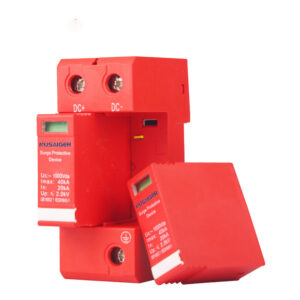PV Surge Protective Device Maintenance, Testing, and Lifespan Management Guide
1. Introduction
PV Surge Protective Devices (SPDs) are vital for safeguarding solar PV systems from transient overvoltages caused by lightning, grid switching, or other disturbances. However, like any electrical component, SPDs have a finite lifespan and require regular maintenance and testing to ensure continued effectiveness.
This guide provides detailed strategies for maintaining, testing, and managing the lifespan of SPDs in residential, commercial, and utility-scale PV installations.
2. Understanding SPD Lifespan
The lifespan of an SPD depends on several factors:
- Rated surge current (In, Imax): Higher currents shorten lifespan if repeatedly experienced.
- Environmental conditions: High temperature, humidity, or corrosive environments reduce longevity.
- Voltage fluctuations: Operating near maximum voltage ratings accelerates degradation.
- Quality and type: PV-specific SPDs with thermal disconnection tend to last longer.
Typical lifespan ranges from 5 to 15 years depending on the system and surge exposure.
3. Routine Maintenance Practices
Regular maintenance ensures SPDs remain functional and effective:
- Visual Inspection: Check for discoloration, burn marks, or physical damage.
- Connection Check: Ensure terminals and grounding connections remain tight and corrosion-free.
- Environmental Protection: Confirm enclosures are intact and weatherproof in outdoor installations.
- Thermal Disconnector Check: Verify SPDs with end-of-life indicators are still operational.
4. Testing SPDs
Testing SPDs helps confirm their protective capabilities:
- Insulation Resistance Test: Ensures no degradation of SPD insulation.
- Continuity Test: Verifies grounding path remains low-impedance.
- End-of-Life Signal Verification: Confirm that indicators or alarms are functional.
- After-Surge Testing: Evaluate SPDs after major lightning events to confirm operational status.
5. End-of-Life and Replacement Strategies
SPDs wear out over time and must be replaced to maintain system protection:
- Replace SPDs after major surge events that exceed nominal ratings.
- Follow manufacturer recommended replacement intervals (commonly 5–10 years).
- Use SPDs with remote signaling for easy identification of end-of-life status.
- Document all replacements and testing for system maintenance records.
6. Common Maintenance Mistakes
- Ignoring visual damage or discoloration.
- Failing to check grounding connections regularly.
- Overlooking SPDs without end-of-life indicators.
- Not testing SPDs after major lightning events.
- Using the same SPD beyond its rated lifespan.
7. Practical Case Study
A 50 MW solar farm in Southeast Asia monitored its SPDs with remote signaling. After a storm, alarms indicated several SPDs reached end-of-life. Maintenance teams replaced the affected devices immediately, preventing potential inverter damage and avoiding downtime. This case illustrates the importance of proactive SPD maintenance and monitoring.
8. Conclusion
Maintenance, testing, and lifespan management of PV SPDs are essential for the long-term reliability of solar PV systems. Regular inspections, testing, and timely replacement of SPDs ensure continued protection of inverters, combiner boxes, and other critical components. By implementing these practices, PV system operators can reduce downtime, prevent equipment damage, and maximize ROI.



